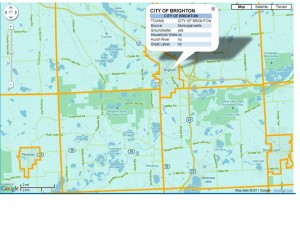 Now Huron River Watershed residents can answer that question, by checking HRWC’s Drinking Water Map. Just click within your community to find out where your community gets its drinking water.
Now Huron River Watershed residents can answer that question, by checking HRWC’s Drinking Water Map. Just click within your community to find out where your community gets its drinking water.
The Huron River itself supplies drinking water to about 150,000 residents of Ann Arbor and Ann Arbor and townships. These communities also rely partly on municipal wells drawing from the watershed’s groundwater.
Other communities with municipal wells include the villages of Barton Hills, Milford, Pinckney and Dexter; the townships of Brighton, Genoa, Green Oak, Hamburg; and the cities of Chelsea, South Lyon, and Ypsilanti.
Many of the watershed communities in the Lower Huron watershed obtain their water from the City of Detroit’s water system, which draws water from Lake St. Clair and the Detroit River.
Also, about a fifth of the watershed’s residents rely on their own household wells for their water supply.
According to a Nature Conservancy poll, an overwhelming majority of Americans don’t know where their water comes from. “When people know where their water comes from, they care more about the health of the land around their water source,” says Matt Herbert, an aquatic ecologist for The Nature Conservancy in Michigan.
Herbert said eighty percent of the water we use as a nation comes from rivers and lakes, but the rest of our water supply comes from groundwater resources, most of which are recharged by the lands above them.
So, next time you pour yourself a glass of water or boil a cup of tea, think of the Huron River, it’s tributaries, wetlands, and aquifers, and about what you can do to keep it clean.



